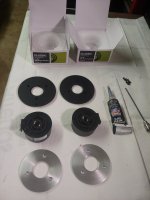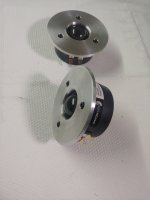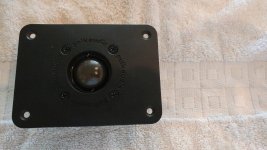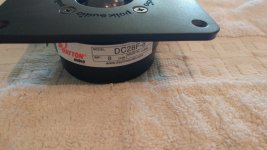Thank you for that reply
I thought of using one DC130-4, which ( I think) would present similar nominal impedance as two 8 ohms in parallel, but have different SPL and impedance profile; I can check that with a sim, which I know won't be accurate as it's not measured in box. However, if I input your XO into Xsim, and then try to replicate the slopes, that might get me in the general area. Apparently Dayton's supplied files are quite accurate.
I also thought of using Curt's TM crossover, as the Tritrix has the same baffle width and driver layout as your TL, but his TM is not a transmission line so it the XO may not be optimal?
I hope you don't mind my 'borrowing' and messing about with your design - please let me know if that's not on.
Geoff
I thought of using one DC130-4, which ( I think) would present similar nominal impedance as two 8 ohms in parallel, but have different SPL and impedance profile; I can check that with a sim, which I know won't be accurate as it's not measured in box. However, if I input your XO into Xsim, and then try to replicate the slopes, that might get me in the general area. Apparently Dayton's supplied files are quite accurate.
I also thought of using Curt's TM crossover, as the Tritrix has the same baffle width and driver layout as your TL, but his TM is not a transmission line so it the XO may not be optimal?
I hope you don't mind my 'borrowing' and messing about with your design - please let me know if that's not on.
Geoff
It’s DIY, go right ahead! Dayton’s FRD files are good but they are probably measured on an IEC wide baffle. The difference with measuring on your own baffle is the diffraction effects and the interplay of the two drivers.
Thank you kind sir!
My DIY is very much DIY: my crossovers look like someone threw the parts onto the board from two metres away and my cabinets are very amateurish....
But I have fun and always learn something.
Cheers
Geoff
My DIY is very much DIY: my crossovers look like someone threw the parts onto the board from two metres away and my cabinets are very amateurish....
But I have fun and always learn something.
Cheers
Geoff
Polar Measurements
I tried a polar measurement with the tweeter just surface mounted no rebate and it looked terrible with sawtooth diffraction. So I added some foam core sheet trim to flush mount it - like it was rebated. I also added some pieces of Scotchbrite scouring pads glued around in a rectangular pattern a la LS5/3A. The measurements now look outstanding. I was using some EQ before to get the on-axis flat response but off-axis the diffraction was still there. So now there is no EQ except for a very mild +1.5dB Q=1.2 at 5100Hz. The data was collected with a 0.5m mic distance and gated 0.5ms before and 5ms after.
The variation is about 5dB up to about 13kHz and mostly less than that. It also shows that the tweeter XO frequency integrates very well with the woofer at 2kHz. Walking around the room it sounds very uniform and I imagine in stereo, the sweet spot would be pretty wide. These budget Dayton DC28F's are very nice performers.
The legend shows values for the cursor at 6kHz.
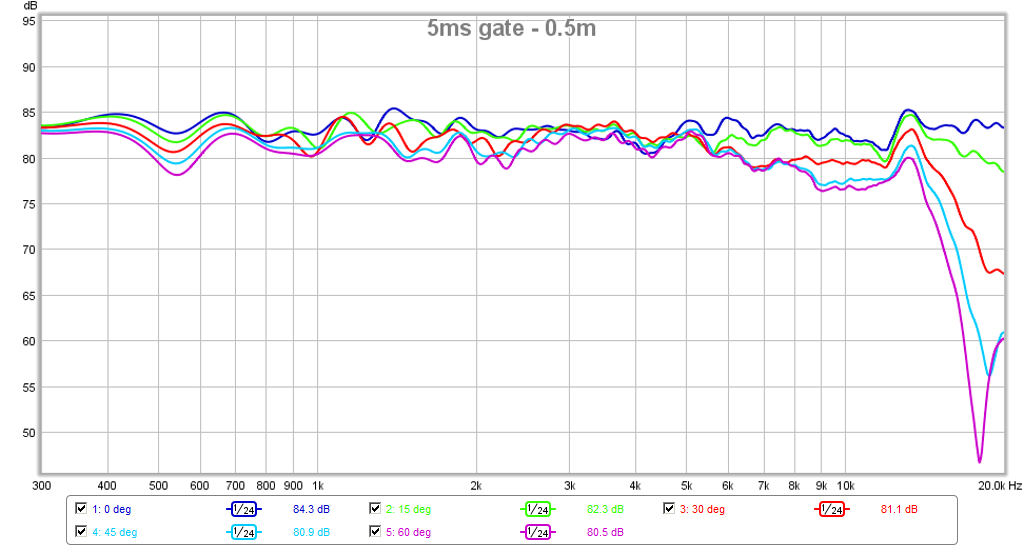
I'm putting these Dayton DC28F's in my 4th set of custom vintage Polks and have found that a billet faceplace brings out much better resolution in these sticky domes...Polar Measurements
I tried a polar measurement with the tweeter just surface mounted no rebate and it looked terrible with sawtooth diffraction. So I added some foam core sheet trim to flush mount it - like it was rebated. I also added some pieces of Scotchbrite scouring pads glued around in a rectangular pattern a la LS5/3A. The measurements now look outstanding. I was using some EQ before to get the on-axis flat response but off-axis the diffraction was still there. So now there is no EQ except for a very mild +1.5dB Q=1.2 at 5100Hz. The data was collected with a 0.5m mic distance and gated 0.5ms before and 5ms after.
The variation is about 5dB up to about 13kHz and mostly less than that. It also shows that the tweeter XO frequency integrates very well with the woofer at 2kHz. Walking around the room it sounds very uniform and I imagine in stereo, the sweet spot would be pretty wide. These budget Dayton DC28F's are very nice performers.
The legend shows values for the cursor at 6kHz.

I really like the TL small bookshelf design here...
Attachments
Nice work on your custom faceplates. Might as well buy RST28F’s which are my go-to dome tweeters nowadays. I have about 5 designs that use them.
Do the RST28's come with an alloy faceplate?Nice work on your custom faceplates. Might as well buy RST28F’s which are my go-to dome tweeters nowadays. I have about 5 designs that use them.
RTV dried quickly...
M4 x 0.7 x 10mm countersink fits perfectly with a 0.185" thick billet plate and countersink holes dialed in to 0.310 wide heads....

M4 x 0.7 x 10mm countersink fits perfectly with a 0.185" thick billet plate and countersink holes dialed in to 0.310 wide heads....
Attachments
Last edited:
They look marvellous, very classy: such a contrast with the standard surround.
Functional, too as the plastic with three screws isn't the strongest.
Well done
Geoff
Functional, too as the plastic with three screws isn't the strongest.
Well done
Geoff
Thank you. It sounds like one too. I originally had a set of shop speakers with them and plastic bezels. I updated the bezel to billet and they came to life.Nice job. Looks like a thousand dollar tweeter!
I agree, 4 screws would be better in plastic, but they still did not have the best clarity/resolution until I machined the billet plates....They look marvellous, very classy: such a contrast with the standard surround.
Functional, too as the plastic with three screws isn't the strongest.
Well done
Geoff
Attachments
I wonder why a metal faceplate makes it sound different? Did you change the way the plate round over interfaced with the tweeter perimeter? Or just a stiffer mounting gave it more resolution?
Probably the stiffer faceplate results in a better damping of unwanted resonances. Had simple Q Acoustics bookshelf speakers and upgraded to the Concepts. The used drivers are the same but the additional pvc/rubber layer between chassis and tweeter results in a so much better clarity. Maybe a similar effect? The Metalplate will resonate in a different register than the thinner plastics faceplate.
I copied the Dayton throat profile, it is the same as plastic bezel contour.I wonder why a metal faceplate makes it sound different? Did you change the way the plate round over interfaced with the tweeter perimeter? Or just a stiffer mounting gave it more resolution?
When I machined a batch of Polk billet plates, I copied their 15 deg throat profile and their large curved face radius on CNC...
The faceplate step / lip at the tweeter dome will have a considerable effect on HF dispersion as well as upper end FR, especially off axis. A good example of this is the dished lip profile Morel uses on some of their higher end domes, emplying a slight dish.
The FP material itself will have very little to do with the character of the tweeter HF response, depending on surfsce texture and some possible diffraction artifacts from screws or other fasteners protruding from the FP surface. It would be very hard to get any detectable ringing from a stiff metal faceplate mounted (essentially clamped) to a cabinet with the speaker playing even at considerably high levels. The only thing I could think of interacting with the faceplate is the mass sum of midrange energy causing minute flex or mechanical distortion in the thinner plastic FP. This modulating with the HF (IM distortion) - that could possibly smear the treble slightly. The metal FP would certainly completely eliminate that. There could also be a change in acoustic center offset between both drivers. That would be very noticeable, even more so if it moves the primary lobe further off tweeter axis.
The FP material itself will have very little to do with the character of the tweeter HF response, depending on surfsce texture and some possible diffraction artifacts from screws or other fasteners protruding from the FP surface. It would be very hard to get any detectable ringing from a stiff metal faceplate mounted (essentially clamped) to a cabinet with the speaker playing even at considerably high levels. The only thing I could think of interacting with the faceplate is the mass sum of midrange energy causing minute flex or mechanical distortion in the thinner plastic FP. This modulating with the HF (IM distortion) - that could possibly smear the treble slightly. The metal FP would certainly completely eliminate that. There could also be a change in acoustic center offset between both drivers. That would be very noticeable, even more so if it moves the primary lobe further off tweeter axis.
HI X,
I liked your design and I m looking for a smaller design, and I have the same woofers and tweeter ( Dayton Budget two-way by Dywane J. ) but find them to be bigger.
So my question is if I use 1/2" MDF can I use it throughout the build that is the inner partitions will it be good, and do I need to use a mini DSP,
Or could I do it without it and I so which XO to follow.
I liked your design and I m looking for a smaller design, and I have the same woofers and tweeter ( Dayton Budget two-way by Dywane J. ) but find them to be bigger.
So my question is if I use 1/2" MDF can I use it throughout the build that is the inner partitions will it be good, and do I need to use a mini DSP,
Or could I do it without it and I so which XO to follow.
1/2in MDF is fine. For the baffle I suggest 3/4in to give enough room for screws to bite into. Or 1/2in plywood on baffle. If you want to use a passive XO, I can suggest switching the tweeter for the RST28F, and using the XO from this speaker. It sounds wonderful and is quasi transient perfect. More here.



Step response measured:

Plus you get the nice bass of the TL. Use 4.9in CTC distance from woofer to tweeter. Make baffle width 7.5in and the XO will work perfectly. Both drivers need to be flush mounted. Make the baffle look like this but add the TL vent of course.

Step response measured:
Plus you get the nice bass of the TL. Use 4.9in CTC distance from woofer to tweeter. Make baffle width 7.5in and the XO will work perfectly. Both drivers need to be flush mounted. Make the baffle look like this but add the TL vent of course.
HI X,
Thank you for the response, currently, the RST28F is out of stock with Partsexpress, so will have to use the DC28F tweeter and in the future once in stock, will replace it.
so for the enclosure/cabinet - if I understand you were ok with 1/2" MDF and for the front, you suggested 3/4" but after thinking a bit I think it will be built with 3/4" throughout. Let me explain why -- I do not have an area in my apartment where woodwork could be done therefore it would have to be a workshop and get it done. And these places in Bombay/India tend to not provide half sheets and have to purchase full sheets.
So i will keep 6" width for path and maintain the height of each lenght of the pass as mentioned 5", 4", 3" and lastly 1.5" till the port. and each partition is 12" in lenght.
I did not undertsnd the part with the 7.5" wide Baffle , it may be more if i use 3/4" so as to maintain the 6" inside. PLEASE CORRECT ME.
the Build will take time - Currently runing around a fabricator for my amplifier case to be fabricated. ( DIY is little too much effort in India ).
Thank you for the response, currently, the RST28F is out of stock with Partsexpress, so will have to use the DC28F tweeter and in the future once in stock, will replace it.
so for the enclosure/cabinet - if I understand you were ok with 1/2" MDF and for the front, you suggested 3/4" but after thinking a bit I think it will be built with 3/4" throughout. Let me explain why -- I do not have an area in my apartment where woodwork could be done therefore it would have to be a workshop and get it done. And these places in Bombay/India tend to not provide half sheets and have to purchase full sheets.
So i will keep 6" width for path and maintain the height of each lenght of the pass as mentioned 5", 4", 3" and lastly 1.5" till the port. and each partition is 12" in lenght.
I did not undertsnd the part with the 7.5" wide Baffle , it may be more if i use 3/4" so as to maintain the 6" inside. PLEASE CORRECT ME.
the Build will take time - Currently runing around a fabricator for my amplifier case to be fabricated. ( DIY is little too much effort in India ).
With 6.0in inside width and 3/4in plywood sides you are at 7.5in external width. This is perfect because the crossover was designed for a 7.5in external width. The cabinet width affects the baffle step frequency and hence the tuning of the crossover.
If you are using DC28F, the impedance is 8ohms whereas RST28F is 4ohms. The crossover filter is off by 2 on the capacitor and inductor. It’s not a drop in fit with the current passive crossover.
Based on impedance scaling alone, double C2 to 10uF. You may need to adjust R4 to level match. Hard to say what L1 needs to be. It’s sort of going to be rough - you may be better off with DSP.
If you are using DC28F, the impedance is 8ohms whereas RST28F is 4ohms. The crossover filter is off by 2 on the capacitor and inductor. It’s not a drop in fit with the current passive crossover.
Based on impedance scaling alone, double C2 to 10uF. You may need to adjust R4 to level match. Hard to say what L1 needs to be. It’s sort of going to be rough - you may be better off with DSP.
- Home
- Loudspeakers
- Multi-Way
- Low-Cost PMC-inspired TL Monitor with DC130A and DC28F
